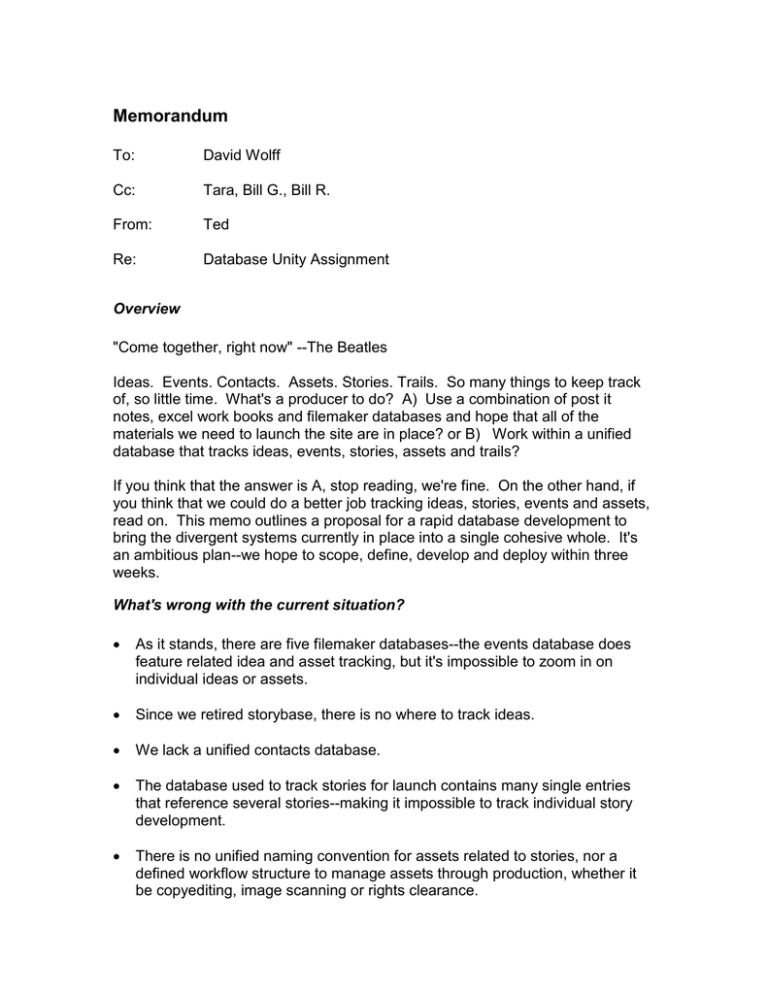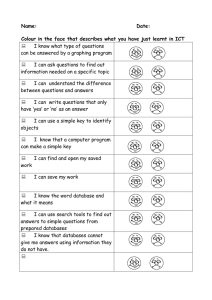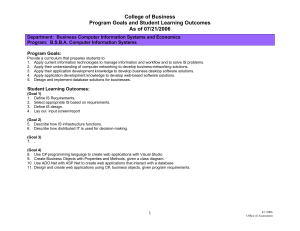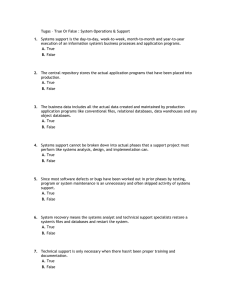Memorandum
advertisement

Memorandum To: David Wolff Cc: Tara, Bill G., Bill R. From: Ted Re: Database Unity Assignment Overview "Come together, right now" --The Beatles Ideas. Events. Contacts. Assets. Stories. Trails. So many things to keep track of, so little time. What's a producer to do? A) Use a combination of post it notes, excel work books and filemaker databases and hope that all of the materials we need to launch the site are in place? or B) Work within a unified database that tracks ideas, events, stories, assets and trails? If you think that the answer is A, stop reading, we're fine. On the other hand, if you think that we could do a better job tracking ideas, stories, events and assets, read on. This memo outlines a proposal for a rapid database development to bring the divergent systems currently in place into a single cohesive whole. It's an ambitious plan--we hope to scope, define, develop and deploy within three weeks. What's wrong with the current situation? As it stands, there are five filemaker databases--the events database does feature related idea and asset tracking, but it's impossible to zoom in on individual ideas or assets. Since we retired storybase, there is no where to track ideas. We lack a unified contacts database. The database used to track stories for launch contains many single entries that reference several stories--making it impossible to track individual story development. There is no unified naming convention for assets related to stories, nor a defined workflow structure to manage assets through production, whether it be copyediting, image scanning or rights clearance. The databases lack robust reporting features. Until recently, we lacked in house database development expertise. How will things be better when this assignment is complete? When this project is complete, we will have a series of related databases that make it easier for producers to manage stories and easier for management to see where stories are in the process. It will also be easier to book crews for events, clear rights, and send tasks to production teams. It will be easier to track assets. Files will have naming conventions. Production staff will be out of the database development business It will be possible to connect these databases to the new content management system when it arrives. What are the performance criteria? We will know that we have succeeded when we have: Staff trained on how to use the databases An integrated database that facilitates Scheduling events Tracking assets Tracking contacts Tracking story ideas Tracking a series of ideas (trails) What is the scope of this assignment? The scope of this assignment is to create a series of related databases that enable the programming and production group to track ideas, events, stories, assets and contacts. We will: Develop a requirements document. Review the document with the production team. Prioritize the feature set. Develop the database architecture. Build the database Test the database Train the staff This database is NOT a content management system, rather, it should track production up to the point where the CMS takes over. It might serve as a upload tool to the production database. (Need to determine if falls outside of scope.) What are the constraints? Self imposed 3 week deadline. Staff time is limited--we've all got other projects Not sure where the database will be hosted--environment is changing. Who is the sponsor of the assignment? David Wolff--this means you decide if we're allowed to spend money on this contraption. Who is the project manager? Ted Bongiovanni is the project manager. He has the authority to make the schedule and will work with the team to make sure that the most important features are built in. He will make final decisions regarding scope to keep the project on schedule. Next Steps Convene the project team. I propose that Tara, Bill G. and I form the core of the team and have full production team review sessions of our work. Bill will serve as database architect and builder. Tara will offer insights on editorial workflow and structure. All other members of the team will be responsible for identifying the most important features and setting priorities.





